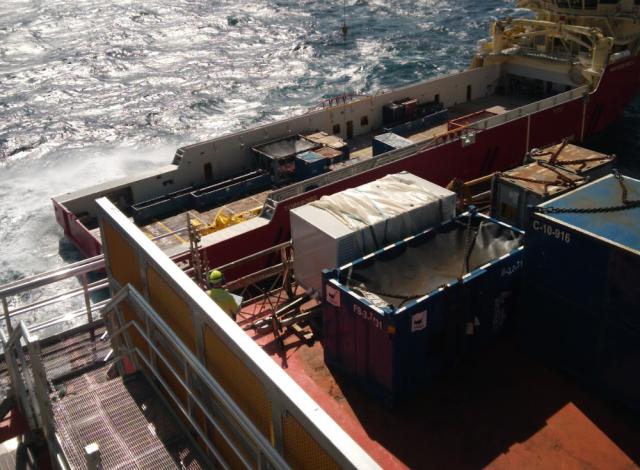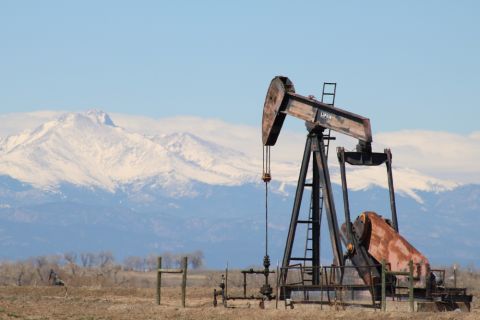
Steel producer Outokumpu teamed with Equinor in Norway to use lean duplex walkway gratings and other products for a modification exercise. (Source: Outokumpu)
The offshore industry is facing an ever-increasing demand to reduce the maintenance costs of offshore structures and their weight. This is driving development and application of new materials technology and design solutions.
A potentially attractive option is to adopt the new generation of lean duplex stainless steel grades that combine many of the beneficial properties of ferritic and austenitic stainless steels. In particular, the duplex microstructure contributes to a high mechanical strength and high resistance to stress corrosion cracking.
While duplex materials have been used in industrial applications for over a decade, they are still relatively new for the offshore industry. But the situation is set to change following the success of some recent pilot projects. Among these was a project carried out in collaboration with Equinor in Norway to use lean duplex walkway gratings and other products for a modification exercise.
Application of Lean Duplex Gratings
Hot-dipped galvanized (HDG) gratings are a commonly used solution in the Norwegian offshore industry. They are available as ready-to-use, cut-to-length products to cover the required surface area. The other candidate material in this application, glass fiber reinforced plastic (GRP), is not fire resistant, doesn’t have the same strength and can’t withstand low temperatures.
The aim of the project was to investigate alternative solutions to existing grating options by selection of a superior material with advantageous characteristics such as higher corrosion resistance, better mechanical properties and weldability. Design/weight, lifetime/maintenance–lower carbon footprint, cost and installation time were also considered.
Material Selection
The key principle in weight reduction is to increase the mechanical strength levels of a product while reducing the thickness of the material used to produce it. The lean duplex used in this project was Outokumpu’s Forta EDX 2304. It has high strength and elongation.
As a result of a higher chromium content in comparison to austenitic grades, the enhanced lean duplex material has a higher pitting as well as crevice corrosion resistance, than 316 stainless steel. In addition, lean duplex has shown higher resistance to stress corrosion cracking.
The welding methods used typically when modifying walkway gratings on offshore installations are shielded metal arc welding (SMAW) and manual arc welding (MAW)–both processes carried out with stick electrodes. Lean duplex stainless steel has, in general, very good weldability and is compatible with most welding methods used for stainless steel grades. Tests have also indicated that welds on lean duplex materials have a high austenite
content in their heat affected zone (HAZ) ensuring that good corrosion resistant properties are maintained.
Designed To Standards
The lean duplex walkway gratings manufactured and tested for this project were based on the design requirements outlined in the current NORSOK standards as well as the experience of the project team in working on offshore modification activities.
Two grating manufacturers based in Germany were involved in the project. At the start, they did not have any duplex materials available in their current portfolio. They also did not have previous experience in working with high strength duplex stainless steel grades. Even so, after being provided with suitable lean duplex coil and bar material, both manufacturers were able to make successful trial runs on their mills without difficulties.
Weight-saving Potential
The lean duplex gratings were based on the manufacturers’ existing HDG grating designs. The two main criteria for gratings are both load carrying capability and deflection.
In tests carried out with varied loadings over a pre-set span, both manufacturers confirmed that they could meet the load and deflection requirements with lean duplex material with a reduced section (30 x 3mm compared with 30 x 5mm for HDG steel). This offers the potential for a weight saving of up to 40 percent.
Reducing Environmental Impact, Carbon Footprint
Utilizing lean duplex grades in production instead of carbon steel solutions with painted or HDG surfaces will minimize pollution and hazardous waste as stainless steel material does not require surface treatment.
The longer life cycle of stainless steel, well in excess of the 20-year life of offshore installations, makes it a superior environmental choice over carbon steel that will require regular maintenance and possible replacement. The increased life expectancy of the lean duplex material will also improve the carbon footprint of the project. Long life and low maintenance is also a very significant factor in optimizing the total cost of ownership (TCO) of the project.
Faster Installation
Avoiding the need for welding operation can generally allow faster installation for offshore projects. This can be achieved with lean duplex material with bolted connections and has a direct impact on the labor time required, resulting in cost savings.
Furthermore, when HDG gratings are cut or modified during construction or modification the cut metal requires treatment against corrosion, which is not needed for stainless steel.
The reduction in weight also allows the possibility for structures to be built onshore and then transported more easily to an offshore installation.
Pilot Project
Following the successful validation of the grating design, the project progressed to the pilot stage. This used the lean duplex gratings, along with other components from the same material, such as beams and plates, in the creation of a new man overboard boat bay for the Åsgard A FPSO vessel. It was possible to use lean duplex stainless steel to replace HDG for about 90% of the complete structure, resulting in a very significant weight savings of 0.56 ton.
Specialized Solution
It is not anticipated that lean duplex stainless steel will be utilized as the main material for the construction of all walkways on offshore platforms. There will be applications where only light weight matters, so GRP will be used. Or in cases where long-life and low maintenance are not critical, then HDG will remain the natural choice. Rather, there will be a number of applications where its combination of high strength, light weight and corrosion resistance will make lean duplex steel a particularly attractive option for achieving the optimum total cost of ownership.
In the near future, lean duplex stainless steel presents an attractive option for modification projects. This is because a key driver for these projects is to not increase the total weight of the platform to avoid the need for rebalancing. Using Forta FDX 2304 to achieve a weight saving of about 40% in the construction of a new structure will facilitate the installation of new equipment with no additional weight burden.
Recommended Reading
Marketed: Confidential Seller Certain Mineral, Royalty Interests in Louisiana
2024-02-13 - A confidential seller retained RedOaks Energy Advisors for the sale of certain mineral and royalty interests in Louisiana.
Marketed: Private Seller Certain Royalty Properties in D-J Basin
2024-02-13 - A private seller retained RedOaks Energy Advisors for the sale of certain royalty properties in the D-J Basin.
California Resources Corp., Aera Energy to Combine in $2.1B Merger
2024-02-07 - The announced combination between California Resources and Aera Energy comes one year after Exxon and Shell closed the sale of Aera to a German asset manager for $4 billion.
Select Water Solutions Bolts On Haynesville, Rockies Assets for $90MM
2024-01-31 - Select Water Solutions Inc. added disposal and recycling capacity in the Haynesville Shale and the Rockies across three acquisitions in January.
Marketed: Anadarko Minerals Woodford Shale Opportunity
2024-02-26 - Anadarko Minerals has retained EnergyNet for the sale of a Woodford Shale opportunity in Blaine County, Oklahoma.


